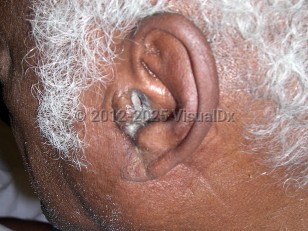Predisposing Factors:
Diabetes is the most significant risk factor for MOE. MOE is commonly seen in patients with immunocompromised conditions, including AIDS, chemotherapy, and malnutrition. A recent history of ear irrigation, ear surgery, or hearing aid irritation is often associated with this condition.
Pathophysiology:
Infection originates in the external ear canal accessing the skull base through the fissures of Santorini (perforations in the cartilaginous portion of the external ear canal). The most common causative organism is Pseudomonas aeruginosa, but MOE has rarely been associated with Aspergillus spp., Candida parapsilosis, Staphylococcus spp., and Klebsiella spp. Those with underlying microvascular abnormalities (as may occur in elderly, diabetic, or immunocompromised hosts) are most susceptible, as organisms gain access and cause vasculitis with thrombosis and coagulative necrosis of the surrounding tissue, including bone, causing osteomyelitis.
Epidemiology:
MOE is more common in warmer climates. Males are more affected than females. Elderly patients are more commonly affected. It is rarely seen in children. Immunosuppressive conditions predispose patients to MOE; in the elderly, diabetes is a common risk factor, while in younger populations, HIV/AIDS increases risk.
Symptoms:
MOE typically presents as severe ear pain, otorrhea, and temporal headache around the involved ear. Hearing loss and/or facial weakness may also occur. Fevers are uncommon.
Signs:
Granulation tissue and edema is a virtually pathognomonic sign that can be seen on examination. Yellowish foul-smelling and persistent drainage can also be seen. Marked tenderness is present between the mandible ramus and mastoid tip.
Potential Complications:
- Temporal and skull base osteomyelitis
- Cranial nerve palsies (most commonly facial)
- Temporomandibular joint arthritis
- Rarely – meningitis, brain abscess; if left untreated, mortality is up to 50%



